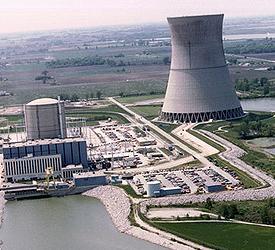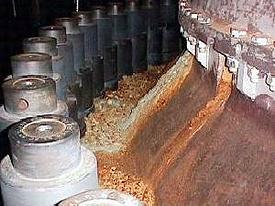ACTUALITE NUCLEAIRE
2008
août
USA: Engineer Lied to Nuclear Regulators
Ohio Nuclear Engineer Convicted of Lying About Cracks in Reactor
Sources:
hosted.ap.org ShortNews.com - Regensburg, Germany
Environment News Service - USA
|
Andrew Siemaszko, a former nuclear plant engineer,
and two other workers have been convicted of concealing material information
for lying to regulators about extreme corrosion at a U.S. nuclear reactor
along Lake Erie.
Voir tous les documents sur cette affaire (Google, en anglais) Environment News Service - USA Ohio Nuclear Engineer Convicted of Lying About Cracks in Reactor TOLEDO, Ohio, August 26, 2008 (ENS) - At Oak Harbor, Ohio, 21 miles
southeast of the city of Toledo, lies the Davis-Besse Nuclear Power Station,
where a hole the size of a football was discovered in the head of the nuclear
reactor vessel in March 2002.

The Davis-Besse nuclear power plant at Oak Harbor, Ohio. (Photo courtesy NRC) "Today, after hearing all the facts, a federal
jury convicted Andrew Siemaszko for concealing the truth from the Nuclear
Regulatory Commission," said Ronald Tenpas, assistant attorney general
for the Justice Department's Environment and Natural Resources Division.
"The effectiveness of the NRC's regulation and the safe operation of
the
nation's nuclear power plants depends on honest and forthright information."
|
The NRC bulletin warned that small boric acid
deposits were a sign of nozzle cracking. In the bulletin, the federal agency
required FirstEnergy Nuclear and other utilities to report on their plants'
susceptibility to cracking, the steps they had taken to detect it and their
plans for addressing the problem in the future.
Because FirstEnergy Nuclear chose not to inspect the nozzles before December 31, 2001, it was also required to justify operation beyond that date. 
Boric acid corrosion on the Davis-Besse reactor vessel head (Photo courtesy NIRS) The jury determined that they were based in part on false information that Siemaszko contributed about his own inspection of the reactor vessel head and information based on video records of inspections conducted by others. Video evidence presented to the jury of the inspection performed by Siemaszko in 2000, showed that the camera used for inspections was physically blocked by boric acid deposits and that very few of the nozzles that were the subject of the NRC's bulletin could be assessed for cracking. At trial, the government proved that Siemaszko knew that he had given false reports and that he presented information orally to the NRC that emphasized false conclusions, including the statement that he was "at peace in his soul" regarding the 2000 inspection results. Siemaszko was convicted of concealing the condition of Davis-Besse's reactor vessel head and of concealing how poor past inspections of that head had been. He also was convicted of using false writings in FirstEnergy Nuclear's interactions with the NRC, including false statements about the extent of inspections done in 1996, 1998 and 2000. After the cavity in the Davis-Besse reactor vessel head was discovered, FirstEnergy Nuclear disciplined a number of its employees. Siemaszko was fired and brought a whistleblower complaint against the company. According to a Department of Labor investigator who testified at the trial, the complaint was fully investigated and dismissed. The investigator testified that Siemaszko admitted during the whistleblower investigation that he lied to the NRC and was terminated for that reason. Special agents of the NRC's Office of Investigations and a senior reactor inspector from NRC's Region III developed the case and referred it to the Department of Justice. The investigation and prosecution were conducted jointly by the Justice Department's Environmental Crimes Section and by the U.S. Attorney's Office for the Northern District of Ohio, as well as the NRC Office of Investigations. Siemaszko's co-defendant David Geisen was convicted on October 31, 2007, on similar charges. Another co-defendant, Rodney Cook, was acquitted. Sentencing in for Siemaszko has not yet been scheduled. Siemaszko has supporters who do not believe that he is guilty as charged. The Union of Concerned Scientists and the advocacy group Ohio Citizen Action both say Siemaszko is innocent. Ohio Citizen Action composed a letter for its followers to send to government officials that says, "The records of Mr. Siemaszko's actions show that he was carrying out his job of cleaning the reactor head in good faith until management brought a halt to the work. By FirstEnergy's own admission, the root cause of the problem began in the mid-1990s, several years before Mr. Siemaszko was even employed at the plant." FirstEnergy Nuclear is a subsidiary of FirstEnergy Corp, based in Akron, Ohio. In April 2005, the company was fined $5.45 million over the Davis-Besse reactor head incident, the largest single fine ever proposed by the Nuclear Regulatory Commission. The main violation was that the utility restarted and operated the Davis-Besse plant in May 2000 without fully characterizing and eliminating leakage from the reactor vessel head, which led to significant corrosion damage. Copyright Environment News Service (ENS) 2008. All rights reserved. |